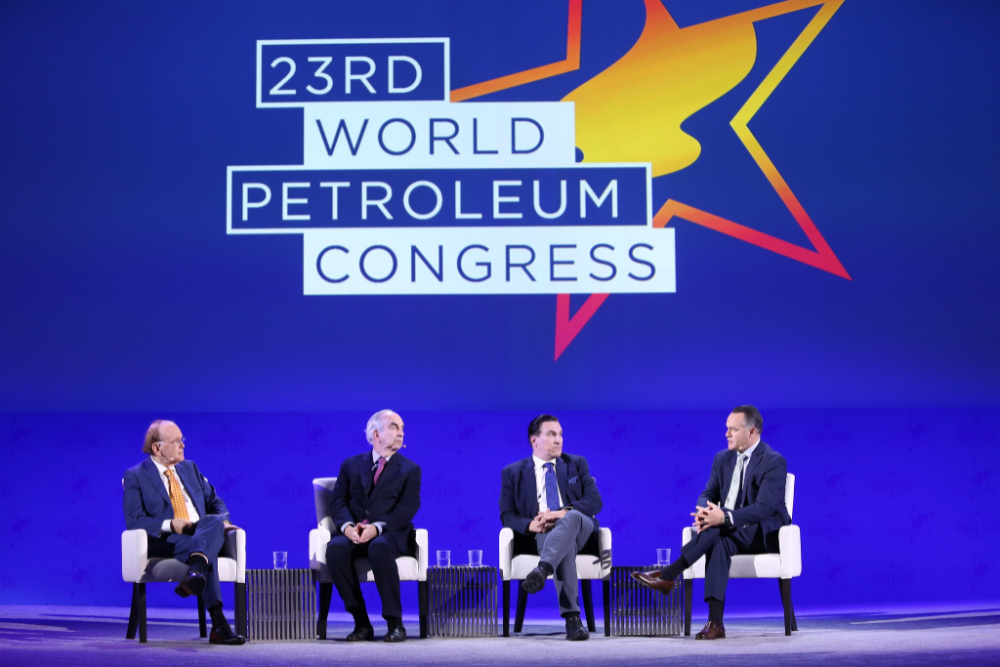
IHS Markit Vice Chairman Daniel Yergin (left) listens to Hess Corp. CEO John Hess speak about the role of U.S. oil and gas in global energy markets at the 23rd World Petroleum Congress in Houston. (Source: World Petroleum Congress)
HOUSTON—Continued underinvestment in oil and gas developments could lead to negative consequences, particularly in developing areas needing access to affordable energy, a trio of energy industry experts warned.
“Unless we start adding to the resource base [such as] in places like Guyana, we’re actually going to be liquidating our resource instead of growing our resource, and that’s probably one of the greatest challenges the world has,” Hess Corp. CEO John Hess said during the recent World Petroleum Congress.
The concern came as the energy transition strengthens amid investor pressure on companies to reduce emissions, operate efficiently and keep spending in check. It also comes as the global energy demand rises and oil and gas fields mature.
“We have a depletion of five to 10% a year, then we have demand growth on top of it of maybe 2 million barrels a day as well,” Hess said. “We need to invest enough in a new resource to grow that. That’s where this longer cycle investment comes in. If you only do short cycle, it’s actually accelerating production from a known resource. It’s not adding to the resource base.”
A joint report released this month by the International Energy Forum (IEF) and IHS Markit show upstream oil and gas investment sank to $341 billion in 2021, 23% below the pre-pandemic level of $525 billion, even as global demand rebounded. Factors posing challenges to investment include price volatility, diverging long-term demand narratives, evolving government regulations and non-standardized ESG criteria, according to the report.
IEF Secretary General Joseph McMonigle called the trend “a recipe for higher prices and volatility,” which he said undermines support for climate action.
“Investment is the greatest challenge the oil industry faces today,” Hess added.
The report indicated that without more drilling, non-OPEC production could drop by an estimated 9 MMbbl/d by 2025 and 20 MMbbl/d (or 41%) by 2030. Without additional drilling, U.S. unconventional supply could drop by an estimated 6 MMbbl/d (or 86%) by 2030.
“In the past two decades, as short-cycle production sources became a greater share of global production, global average annual decline rates have increased,” the report stated.
Harvesting Mode
U.S. shale has gone from a growth industry to a harvest industry, according to Hess, who said future energy supply must come from “all of the above.”
The U.S. Energy Information Administration forecasts U.S. crude oil production will rise to an average 11.8 MMbbl/d in 2022, ending the year at just over 12 MMbbl/d.
Oil production could reach pre-COVID levels of 13 MMbbl/d in the next three years, but then it is expected to plateau. “People don’t realize the Bakken, where we’re an operator, is pretty much at plateau rates, and it should stay there for the next several years,” Hess said. “The Eagle Ford … is also at a plateau rate of about a million barrels a day.”
The Permian Basin is seen as the only growth engine for U.S. oil production over the next several years. “But then it plateaus,” Hess added. “So basically, we see shale and U.S. production plateauing, let’s say, in 2023, and then it stays flat. So, there’s only so much the U.S. can do.”
The next couple of years will be critical in terms of new project sanctioning and capital allocation, McMonigle said.
“Unfortunately, I think for the first time in ages, there’s not a single megaproject in the works right now,” he said.
Among the latest was Woodside Petroleum and BHP Group’s decision to develop the $12 billion Scarborough gas field offshore Western Australia and expand the Pluto LNG project.
“We really need these long-cycle projects or longer cycle projects to provide the energy security we need,” McMonigle said.

Another big challenge facing the industry, according to Hess, is growing global energy supply while trying to reach net-zero by 2050.
Under all of the energy scenarios in the International Energy Agency’s World Energy Outlook, each includes oil and gas though comprising smaller percentages of the energy pie compared to today. The scenarios indicate that about $450 billion worth of oil and gas investment will be needed, Hess said, to meet the world’s energy needs.
“We’re way short of where we need to be,” he said, stressing the importance of educating policymakers, business leaders, academia and the public. “Oil and gas [are] going to be needed for the next 10 to 20 years.”
Investment in clean energies also needs to increase, Hess added.
“It’s not either-or it’s and,” he said. “At the end of the day, to have an orderly and just energy transition, oil and gas are part of the solution, not the problem.”
Right, Wrong Ways
Favorable regulation would also help, panelists agreed. However, Mike Sommers, president of American Petroleum Institute (API), pointed out that the current U.S. administration’s action implies this type of investment is not wanted.
He mentioned the cancelation of the Keystone XL pipeline, the pausing of leasing and permitting on federal lands and waters, halted exploration in the Alaskan National Wildlife Refuge and talk of banning oil exports, something which the Biden administration said it is not considering.
RELATED: US Lawmaker Introduces Bill to Eliminate 45Q Carbon Credits for Oil Recovery
“There’s a right way and a wrong way approach to dealing with these [energy and climate] challenges… and I do think that the policies matter,” Sommers said.
The API’s Climate Framework supports a carbon price policy; further mitigating emissions from operations; advancing cleaner fuels and accelerating technology such as fast-tracking commercial deployment of carbon, capture, utilization and storage (CCUS).
Asked by moderator Daniel Yergin, vice chairman of IHS Markit, what advice he would give the Biden administration, Sommers said it should recognize the U.S. oil and gas industry’s part in today’s global environmental movement.
“A great example: U.S. LNG exports are one of the most important environmental movements in the world today because we are replacing coal in countries that are still burning coal with cleaner natural gas,” Sommers said. “That is one of the key reasons that the United States leads the world in greenhouse-gas emission reductions, and we need to be exporting that environmental progress all over the world.”
Common ground could be found in ensuring LNG and crude oil exports continue, getting a price on carbon, reducing emissions and investing in CCUS technologies, he added.
Panelists commended the administration for its support of CCUS.
It is also important to have a master plan, not “seat of the pants regulations that may be constructive or may be punitive,” Hess said.
Hess also believes there should also be a price on carbon and everyone—including the oil and gas sector—should have a seat at the table.
“If we’re really serious about solving the climate challenge and having an orderly and affordable energy transition,” he said, “we have to get more business leaders in the administration as well as oil and gas leaders in the administration to have sustainable development.”
Recommended Reading
Occidental’s Lithium Technology ‘Ready for Prime Time’
2024-03-20 - Occidental is leaning towards a ‘build, own and operate’ approach to growing its direct lithium extraction business.
IBAT, US Mag Partner to Advance Modular Direct Lithium Extraction Plant
2024-05-06 - Full commissioning and startup of the commercial modular direct lithium extraction plant being developed by US Magnesium and International Battery Metals is expected within three months, the companies said May 6.
Amid ‘Battery Arms Race,’ Xerion CEO Talks Tech, Maturing Market, China
2024-04-10 - The late-stage battery startup is active in the military and electronics space, but is gaining attention for technology that extracts lithium from geothermal brine.
Elephant in the North: E3 Lithium CEO on Finding Opportunity ‘Hunters’
2024-02-28 - E3 Lithium is working toward commercial lithium production for its Clearwater project in South-Central Alberta’s Bashaw District, while developing its own DLE technology.
Exclusive: Building Battery Value Chain is "Vital" to Energy Transition
2024-04-18 - Srini Godavarthy, the CEO of Li-Metal, breaks down the importance of scaling up battery production in North America and the traditional process of producing lithium anodes, in this Hart Energy Exclusive interview.






